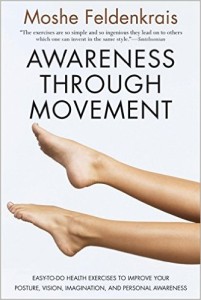While Moshe Feldenkrais’s 1972 book titled Awareness Through Movement is one of his most accessible works, his scientific writing and broad musings about the social and anthropological implications of his discoveries can be challenging to parse.
The whole book is worth reading, but I’ve highlighted below the sections that are most helpful if you’re working through the lessons with my recorded versions. You’ll also find a recommended study order for the lessons.
Feldenkrais’s instructions are hard to follow while holding a book, so I recommend first listening to a lesson in our ATM book lesson collection, then reading through it in the book to reinforce its principles and integrate your learning. His commentary can really help elucidate the lesson.
Later, after your first listening and reading, you can lead yourself in the doing the complete lesson from the book or stick with the audio if you prefer. You can also use the book to refresh small parts of the lesson, or use it as a tool for imagining feeling the movements or principles of the lesson, which can be extremely helpful for your learning and improvement.
– Nick Strauss-Klein
Feldenkrais on how to study at home
Read his introductory sections before the lessons in Part II: General Observations and Some Practical Hints. For another list of practical tips straight from the man himself, check out his Learn to Learn pamphlet.
Feldenkrais on what the Feldenkrais Method is
Check out these sections in Part I: Understanding While Doing. I’ve prioritized them in what I think of as the most practical order (not the order they appear in the book).
- Where to Begin and How
- Structure and Function: Read from the subsection “The delay between thought and action is the basis for awareness” and onward.
- The Self-Image
The other sections of Part I, including the preface, may be of interest to you. I’ve left them out here because they contain broader reflections about society and our state of education and personal development. If our goal is to focus on self-improvement from practical application of the lessons in the book, I believe your understanding of Feldenkrais’s ideas in these sections is perhaps less important than what may be gleaned from the sections I’ve highlighted above.
Recommended study order for the lessons
Lesson #2, What Action Is Good is a free talk which can serve as an introduction to the series.
I recommend NOT studying the rest of the lessons in Feldenkrais’s numerical order. Below I’ve organized them by my own perceptions of their level of difficulty* for the average student.
Within the categories I’ve simply left them in numeric order, but again, there’s no need to study them in that order. Click the links and follow your curiosity.
– Nick
These audio recordings are exclusive “thank you” content for Patron-level supporters of The Feldenkrais Project.
All users can click the titles to read these lessons’ descriptions, free lesson notes, and listener comments.
Most accessible
#4 Differentiation of Parts and Functions in Breathing
#5 Coordination of the Flexor Muscles and of the Extensors
#6 Differentiation of Pelvic Movements by Means of an Imaginary Clock
More complex
#3 Some Fundamental Properties of Movement
#7 The Carriage of the Head Affects the State of the Musculature
#10 The Movement of the Eyes Organizes the Movement of the Body
Most challenging, in one way or another
#9 Spatial Relationships as a Means to Coordinated Action
* Other people’s ideas about the difficulty of Feldenkrais lessons always come with a “your mileage may vary” caveat. These lessons have wildly varying levels of physical and attentional challenges, and each of us has unique abilities in both of those spheres. Something that one person finds impossible to do or notice, another may find spontaneously easy or fascinating.



I am looking for a book on Feldenkrais method that at the end had several case histories which were clear easy to understand. As a result we did several classes with Mia Segal. She was in ny at time immeasurably helpful. Have been doing it over years. I would really appreciate it if you could guide me to this book. Need it for a friend. I think case histories would her believe our tale of success. We are now in florida ages 84 And 90
I know Feldenkrais people are good and kind as well as gentle. Will appreciate your help
I don’t remember off the top of my head but I could dig in my library a little. Are you sure you’re not thinking of The Case of Nora? That’s all one big case study, and it’s remarkable.
I found my book Awareness thru movmen by Feldenkrais but could not find case I meant about 1st violinist whose finger was damaged and restored by Feldenkrais himself. I did Not mean the book of NORA. Thank you for recommending it and for answering my note.
Evelyn, maybe you are thinking of the book by Yochanan Rywerant, The Feldenkrais Method, Teaching by Handling. There are some case histories in the end and one is regarding first flutist.
Thank you very much. That is surely book I meant. Is it available second hand? Will be away till Dec 15 so may not answer till then. Can’t thank you enough